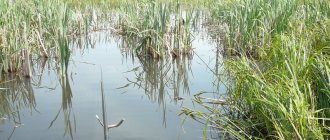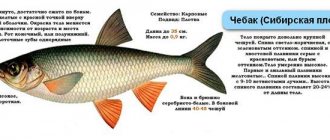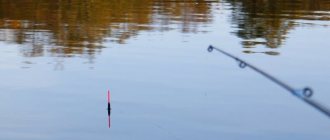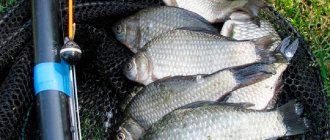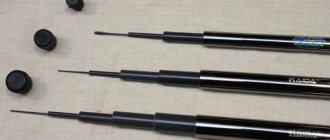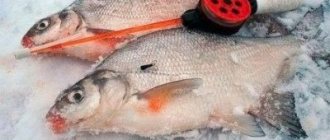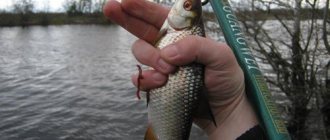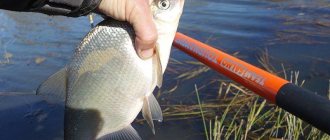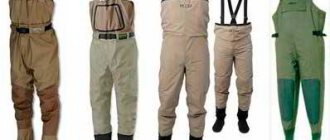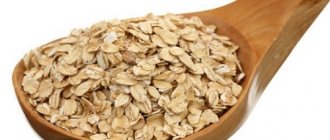A little about roach
It is difficult to classify a roach as a trophy fish, but if delicate rigs are used to catch it, catching a 200–300 gram roach gives an unforgettable experience. This will be surprising news for some fishing enthusiasts, but the roach is a relative of the handsome carp and even looks vaguely similar to it.
The average weight of this fish is 50–200 grams, but trophies weighing 300–400 grams or more can be found, and this happens especially often when roach is caught in June using a float rod, because during this period, the fish is actively looking for food and moving along familiar underwater paths .
This is important information for anglers, because if you find such trails, there is hope for a good catch of large roach.
In different parts of the country this fish is called:
- sorogoy;
- ram;
- roach.
But we are talking about the same fish with a small head, a wide dark back and orange-red fin feathers. The grass roach, which mainly lives in rivers, is externally distinguished by its elongated, flat body and small size of individuals.
If in the spring or autumn, in cold water, the fish needs protein and responds better to animal food, then in the summer it prefers baits of plant origin such as:
- boiled pearl barley;
- test;
- hominy;
- soaked wheat.
And ordinary white bread, mixed with flour, becomes a very attractive bait for roaches, so there is no need for store-bought, artificial baits. All these baits are easy to prepare at home and do not take up much space when moving to a pond.
To achieve a decent catch of roach in the summer with a float rod, the angler needs to:
- choose the right place where the roach is located;
- feed the fishing point generously;
- find a catchy bait;
- choose the depth at which the fish is standing.
What is the best way to feed roaches?
If you want to return home with a decent trophy, then do not skimp on the bait mixture. Quite often, soil taken from the shore of a reservoir is used as a base for bait mixtures. It can be mixed with sweet cookies or breadcrumbs. After this, you can add food bloodworms or maggots to the resulting mixture. The bait should mold freely into balls. You can achieve the desired consistency either by adding soil to the bait mixture, or by adding water from the reservoir in which you are fishing to the bait mixture.
Recommended reading: Fishing for carp in summer
How to feed during the current
If fishing is carried out on the current, choose the bait with which you can create a real edible cloud from the bait mixture. For these purposes, we focus on two points. Firstly, the basis of the bait should be a product capable of producing such a cloud. Secondly, the bait should be placed in a fine mesh net. A stone is placed in the same grid. After this, the net with bait is lowered at the fishing site. The current washes out the bait and carries it down. The roach standing downstream reacts to this fact and goes in search of a source of food. Ultimately, she approaches the bait bag, into the fisherman's fishing area. Now all you have to do is move the bait close to the potential prey. When fishing in the current, line fishing is usually used. But you can also lower the weight to the bottom, thereby making the equipment stationary. Either of these scenarios will result in the roach being caught.
When catching roach with a float rod, you can also use a special bite activator. A similar bite activator is added to the bait. Some additives not only serve as flavoring, but also make the fish hungry. The roach begins to feed and, of course, gets hooked.
Advantages of catching summer roach on a float
Roach can be caught using all types of fishing gear with the exception of spinning rods.
This fish comes across:
- on donks;
- for float gear;
- for feeder installations;
- on the ring;
- for bream rigs.
In the summer they catch roach from the shore and from a boat, and float gear has proven to be the most catchy. Fishing for a 200-gram roach on a donk is not so interesting, because the small fish offers virtually no resistance and there is little pleasure in such a process.
But summer roach fishing with float rigs is a really exciting activity that requires attention and skill. It is only at first glance that it seems that there is no difficulty in such fishing, because an approaching school of roach pleases with frequent bites and the fisherman seems to only have to make timely hooks.
But in order for such a school to approach the chosen point, you need to be able to attract it, and in order for the fish to take the bait, it must be appetizing and attractive.
Advantages of catching roach using float gear:
- the use of delicate rigs and small hooks does not alarm the fish, and they willingly take the bait;
- when casting gear there is practically no noise, and an approaching school of roach is not afraid of incomprehensible sounds;
- precise and quiet feeding by hand or with a slingshot allows you to keep the fish at the fishing point;
- when fishing with a float, the angler quickly changes the depth at which the bait is located and quickly finds the fish in the water column;
- vegetable baits do not jump off the hook when casting with float tackle and hold well while waiting for a bite;
- hooking and landing the caught fish is almost silent.
During summer roach fishing, it is important to maintain silence on the shore, because the tackle is cast close to the shore, and the fish are shy and wary of any noise.
Depending on the length of the float rod, fishing for roach is carried out at a distance of 10–15 meters from the shore and it is easy for the angler to feed the point by hand or with a slingshot, which increases the chances of a good bite.
Since the size of the roach is very small, in the summer it is caught with small hooks, which are covered with dough or hominy. When casting forcefully over a long distance, such a bait will most likely fly off the hook, but float tackle allows the use of soft baits, which is also its undoubted advantage.
In summer, schools of roach move in the water column and in order to achieve a bite, you need to choose the right depth for the bait. During the day, the behavior of the fish changes, and it can either sink to the bottom or rise to the surface of the water. By moving the cambric that secures the float, the angler quickly changes the fishing depth and the bite returns.
After the bite, it is easier to make a clear, accented hook with a float rod, and quiet fishing does not scare the fish located at the fishing point.
Fishing rod equipment for roach fishing
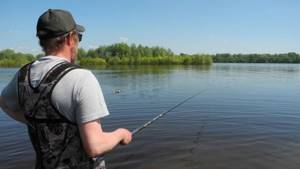
As we said above, there is no reel on the fly tackle. In the case of a Bolognese fishing rod, a small spinning reel of the 500-1000 class will perform best. The compact spool of such a reel will be able to fit the required supply of fishing line. Because when fishing for roach, a relatively thin fishing line is used. Plus, the mass of such a coil will always be less than one of a similar price, but of a larger size.
fishing line
When fishing, use monofilament fishing line with a diameter of 0.01 - 0.16 mm, depending on the size of the prey. This is enough to catch prey. You should not choose an excessively thick fishing line. Because when biting, the roach may feel resistance and spit out the bait.
Float
It is better to choose a spindle-shaped float. It has low resistance when biting, and therefore will not arouse suspicion among potential prey. Most often, the float is attached to the fishing line using cambrics. But in the case of Bolognese tackle, a sliding float is sometimes used. It is especially in demand when fishing is done at great depths.
Sinker
Lead pellets are used as a load when fishing for roach using a float rod. It is better to equip your fishing rod with several small lead pellets than with one large load. Lead pellets allow you to more finely tune the tackle during the fishing process.
Hook
The hook should be as thin and miniature as possible. With this hook it is much easier to hook fish, plus the bait looks more natural. But it’s not worth it to unnecessarily force the fishing when fishing with a hook made of thin wire. Because such wire can tear the roach’s delicate lips or the hook itself will break.
Where to look for roach in summer
As already mentioned, an important condition for a stable roach bite is the correctly chosen place on the shore. Beginner fishermen often rely on their own convenience and locate themselves where there is a good approach to the water's edge, free space for bags and hard ground.
But this is not true, and successful float anglers sometimes have to mow down reed bushes at the beginning of fishing in order to get closer to a promising place.
Despite the fact that in summer the roach does not stay long at one depth or at one point in the reservoir, the following are considered promising from the point of view of catching it on the river:
- areas with reverse flow;
- shaded areas with lush vegetation;
- backwaters with relatively stagnant water.
Under trees, roaches look for insects falling from their branches, the same applies to areas overgrown with reeds or other vegetation. In a quiet backwater with stagnant water, fish rummage through the soil in search of larvae and worms and bask in the sun.
In reservoirs with stagnant water, the following areas are considered attractive for roach fishing:
- with sandbanks and shallow depths;
- with edges and sharp changes in depth;
- next to lush vegetation and water lilies.
In still water, float fishing seems more attractive, especially if there is no strong wind, but as practice has shown, where there is a current, the fish are less timid and take the bait more confidently, feeling competition from other individuals in the school.
Large roach can be caught well in the summer in the evening and at night, in the bottom layer at changes in depth. In the morning, the fish rises to the upper layers and has to be searched for, experimentally selecting the depth.
Towards mid-summer, schools of roach gather in places rich in food and move around the reservoir less actively, which, of course, benefits fishermen. In hot weather, during the day there is practically no roach bite and only early in the morning or at dawn are good catches of large fish possible.
But during rain or cloudy weather, roaches bite throughout the day, especially when the atmospheric pressure decreases. After a thunderstorm, the fish become more active, and float fishing lovers should take advantage of this.
Choosing a place to catch roach
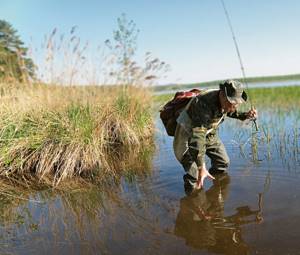
The choice of place to catch roach should be approached with special care. If you plan to fish in conditions of a small current, choose a fishing point on the border of the current and calm water. It’s even better if there is a reverse flow - “return”. Well, it’s really good if in this place there is a hole or depression into which various food is carried by the current, and where the roach will actually feed. If fishing is supposed to be in a reservoir with stagnant water, choose places on the border of algae and clean water, or near the walls of reeds and cattails. In such places, roaches actively feed on small aquatic organisms, insect larvae, and some types of vegetation. For its habitat, roach most often chooses areas of reservoirs with a depth of 1.5 - 2.2 meters. Roaches rarely fall below this horizon due to decreased oxygen content and lower water temperature. Roaches do not enter the upper layers of water and shallow waters due to their caution. Roach is a schooling fish and extremely shy. This should be taken into account when fishing and when choosing a fishing spot. Loud conversations, music while fishing, loud “fluttering”, even bright clothing of a fisherman on a sunny day can force a school of roach to leave the feeding area.
How to catch roach in summer
Depending on the type of reservoir, the method of float fishing for summer roach is selected.
It could be:
- fishing in the current;
- static fishing in still water with a floating bait;
- static fishing in weak currents and in a still body of water with a bait at the bottom.
Fishing in the wire
Wiring fishing is carried out from the shore or a boat on a river with a current. In this case, the fisherman throws the equipment upstream and it is carried away by the water flow to the lower critical point.
After the float makes a full pass, the angler checks the condition of the nozzle and rethrows the tackle to the top point. When biting, a sharp hook is made towards the shore or up. The depth of insertion of the nozzle is adjusted by the height of the float on the fishing line and can be quickly changed if necessary.
Wiring fishing is active and the angler holds the rod in his hands, so special requirements are placed on its weight. It’s more difficult to work with a heavy blank, and the angler’s physical load during a whole day of fishing is considerable, so it’s better to take a light fishing rod.
The bait is thrown into the sector so that after each cast the hook with the nozzle passes in close proximity to the baited point.
Static fishing with floating bait
This is the simplest and most comfortable type of fishing for roach in still water using a float. After the fishing spot is abundantly baited, the angler sets the float so that the bait floats in the water column and casts the tackle.
The rod is placed on stands and picked up only after a bite, or if you need to re-cast the tackle. The weight and float balance each other and the bait is in a neutral state.
This method is good because when biting activity decreases, the fishing depth quickly changes and the search for fish becomes easier. Throughout the day, schools of roach change their location, for example, when the pressure decreases, they drop closer to the bottom, and when the pressure increases, they move across all horizons. Taking this into account, exploratory fishing brings real results, and is therefore considered the most effective.
You need to catch roach in summer with floating bait in places where there is no bottom debris, snags or other obstacles. Otherwise, during passage, the hook will cling to obstacles and create problems for the angler.
Static fishing with bait on the bottom
This method of catching roach with a float is considered a hybrid and is very similar to fishing with a donka.
In strong currents, keeping the bait on the bottom is difficult, if not impossible, so static fishing is used for:
- lakes;
- rates;
- paid reservoirs without current;
- reservoirs;
- small rivers with weak currents.
The principle of static fishing with a bait on the bottom is that, having determined the depth at the fishing point, the fisherman raises the float 20–30 cm higher and throws the tackle to the point. The sinker is selected a little heavier than the float test and it turns out that the nozzle remains on the bottom in one place, and when a roach bites, the float immediately signals this to the angler. Hook - and the fish is on the hook!
The advantages of this method are that the bait is always thrown into the same place, and does not float above the bait. While eating food at a point, the fish finds the bait and gets hooked. The float antenna is located on the surface of the water and reacts sensitively to any touch to the nozzle.
When fishing with this method, the catch contains more large fish, but you need to be able to attract them to the fishing point.
The choice of method for catching roach with a float in the summer depends on the type of reservoir and the conditions in which fishing takes place, including weather.
What places does the roach stick to?
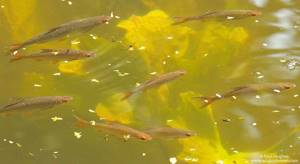
In the second half of summer they can eat like this all day long. The habitats of roaches depend on the nature of the reservoir. Both standing and flowing reservoirs have their own characteristics.
If fishing is carried out on the current, you should look for roach in places around the bends of the river. In such areas, places with weak currents form. It is here, on the border between fast current and calm water, that this fish most often stands. At the same time, she grabs food floating by. If you place bait here on a float tackle, the bite will follow immediately.
It is worth paying attention to various objects at the bottom of the river. These could be flooded snags, thickets of aquatic vegetation, destroyed bridges and much more. Again, immediately behind such objects an area of calm water forms. Often, fish such as rudd, perch and chub stay here together with roach. So be prepared for variety. True, the roach stays more near the bottom. But the same chub occupies the upper water horizon.
We recommend reading: How to distinguish a silver bream from a white bream quickly and accurately
You can also find roaches in large holes and riverbeds. Moreover, the deeper the hole, the greater the likelihood of catching a trophy specimen. In addition, you can count on biting some other trophy fish. Because large fish almost always rest in large pits.
If in flowing reservoirs roach usually stays in strictly limited places and it is quite easy to detect them, then in standing reservoirs everything is not so clear. Here she has much more freedom of action. And often flocks migrate throughout the entire water area of the reservoir. Most often it stays on dumps. In those areas where there is a transition from a shallow depth to a significant depth. The upper part of such an edge is usually occupied by rudd. But at the foot of the edge you can count on a roach bite. Bream often coexists with it in such places.
In stagnant bodies of water, the “chebak” likes to stay in thickets of aquatic vegetation. Therefore, you can catch it by casting it out the window among aquatic vegetation.
Float gear for summer roach fishing
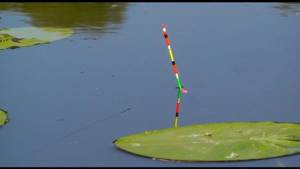
The advantages of summer fishing with float gear are beyond doubt, but to catch large roach you need to choose the right rigs and choose a rod, reel, and fishing line.
From June to August, anglers use the following rods to hunt roach:
- Bolognese;
- flight feathers;
- match.
Each case has its own characteristics, but most often the choice depends on the habits and preferences of the fisherman himself.
They fish with a match rod at a long distance, but for roach this condition is not mandatory, since schools of this fish come close to the coastline without fear.
A fly rod allows you to use the simplest rigs and soft baits, but with a solid length of 8–10 meters, it is not very convenient and requires fly fishing skills, which not all fishing enthusiasts have.
Bolognese rods also have their advantages and are most often used for roach fishing in the summer.
Match
So, match float rods are selected if fishing is carried out:
- from the shore at a long distance on a river with a weak current;
- from the shore at a distance, on a standing body of water, reservoir or headquarters;
- from a boat when fishing under reeds and needing to cast more than 15 meters.
A match rod is taken 4-4.5 meters long, this is enough to cast the tackle to the desired point. A reel with a main line with a diameter of 0.2 mm in a neutral shade or the color of the water is placed on the match. Sliding float, leashes made of monofilament 0.12-0.14, hooks for a selected nozzle.
The size of the hook for catching roach in the summer with a match rod should correspond to the bait that the fish will be tempted by. Naturally, when fishing with maggots, you will need a very small hook (number 16-18), but when using dough, the hook size is smaller (number 12-14), but the thickness of the wire is greater, so that the bait does not fly off when casting .
Expert opinion
Vladimir Poltoranin
Fisherman - expert
The advantages of catching roach for the match are that you fish far away, where the timid fish stands and waits for a tasty treat. But this gear also has a serious drawback, which negatively affects the size of the catch. After casting the equipment, the hook with the nozzle slowly lowers in the water column. But if there are a large number of fish at the fishing point, a bite may follow, which is called “flying in,” even before the float takes its working position.
It turns out that the fisherman is confident that the bait on the hook is safe and sound, but in fact it was stolen long ago by a fish. The solution to the problem will be to make the load heavier, but a float will also be needed with a larger load capacity, which means it will be less sensitive.
It must be admitted that match gear is rarely used for catching roach in the summer, because anglers, avoiding long casts, lure the fish closer to the shore, where they are caught with a fly or Bolognese fishing rod.
Fly feathers
A fly rod is preferable for roach in summer on rivers with currents and on lakes. This applies to static fishing and wire fishing. The absence of a reel makes the gear lighter and simplifies its use, and rods up to 10 meters long help you fish the entire coastal zone without fuss and unnecessary movements that frighten the fish.
Swing fishing is practically silent and therefore, even being in close proximity to the shore, the fish is not afraid of loud sounds and splashes, as is the case when fishing for a match.
To install the equipment on the roach, select a main line of 0.14-0.16, and leashes of 0.10-0.12 mm with hooks suitable for the selected nozzle. It is advisable for the fisherman to have a supply of leashes, because when fishing with a fly rod, when hooked, you have to break off the equipment. Tying leashes with hooks directly on a pond is not always convenient, so you need to be fully prepared.
Fishing from a boat with a fly rod is also effective due to the absence of noise and the ability to cast the equipment directly under the reeds, while being at a distance of the length of the rod, which is 4–9 meters.
It is more convenient to control a fly rod from a boat than, say, a match rod; this also applies to casting and landing caught fish. Even trophy roach rarely exceeds a weight of 400–500 grams, so there is no danger of breaking the form when fishing or hooking a heavy fish.
Despite the fact that the roach does not resist very actively, it is better to buy a high-quality fly rod, because it is lighter and stronger than budget models. When fishing with a float or a fly, you have to hold the rod in your hands for several hours and every extra ten grams of its weight, of course, affects the convenience of the fisherman.
Expert opinion
Vladimir Poltoranin
Fisherman - expert
The advantage of fly fishing gear is that with its help the most fragile and delicate bait is delivered to the fishing point. Power casts are not used when catching roach on the fly, and the rod carefully delivers delicate baits such as dough or hominy, which break when they hit the water, to the desired point.
They fish with a swing both in the retrieve and in a static position, and with such a rod it is more convenient to perform sharp hooks, and they are needed when fishing for roach in the summer. It is more difficult to operate from a boat with a blank that is too long, so in such cases fly rods 4–6 meters long are most often used. Light floats are used with a swing, because thanks to the design of the blank and tackle, they quickly take the working position when casting.
When using a fly rod for line fishing in the current, it makes sense to twitch the tip of the blank when the float reaches the lowest point. The playing bait attracts the fish more actively, and it decides to bite. After the bait gets into the water, a large roach accompanies it as it moves through the water column with the current, carefully examining it and fearing a catch. But the active actions of the fisherman provoke the fish, and it cannot resist trying to taste the mouth-watering treat.
When fishing on the fly and the bite subsides, change baits after each recast of the tackle, this helps in attracting fish.
Bolognese
Bolognese fishing rods are considered the most affordable and accessible both in price and in terms of acquiring the ability to use the tackle. Most float anglers began doing what they loved with Bolognese rods, which were more convenient to transport and prepare for fishing.
They fish with lapdogs both from a boat and from the shore, and fish not only the coastal zone, but also medium and even long distances. When collecting fishing gear close to the shore, it is surrounded by 3-5 pellets, thanks to which the bait sinks into the water faster. This is an important point, since easy installation does not show a decent result when catching active fish.
The bait is pulled off the hook by the fry before the tackle takes a workable position, and the angler doesn’t even know about it. Therefore, slowly sinking the hook with bait is unprofitable and you need to use pellets to solve this problem.
When catching roach in summer from the shore using Bolognese tackle, floats of 2–4 grams, which have an elongated shape, are used. The float must be immersed so that after casting, only a part of the antenna 3–5 cm long remains on the surface of the water.
If the weather is windy, then the visible part of the antenna should be larger; during calm weather, it is enough that only the tip of the bright-colored float antenna is visible. Red is considered to be the most noticeable color, although some anglers prefer to look at an orange or even yellow antenna. So there are no strict recommendations here, and each angler chooses what is more convenient and profitable for him.
When catching summer roach with Bolognese tackle from a distance of 15–20 meters, select a sliding float with a carrying capacity of 6 grams or more. This choice is due to the need to make a power cast, otherwise getting to the fishing point will be difficult, if not impossible. It is preferable to use an olive sliding sinker that does not cling to grass and stones when moving.
For long distances, large floats are needed, but delicate bites are not always visible from them. In summer, this is not too critical, since the fish is looking for food and greedily attacks the bait without delay, swallowing it completely. This bite is clearly visible even with a large float. But in the fall, in cold water, when the fish are inactive, long-distance fishing with Bolognese tackle is ineffective, and it is better to use a fly rod.
Conclusions: The fly tackle is considered the most catchy for summer roach and is used by most float anglers. But in the absence of a fly rod, they use both Bolognese and match gear; the main thing is to select the weight of the float and load so as to ensure maximum sensitivity.
When and what do you use to catch roach?
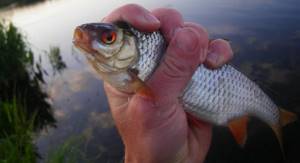
They catch roach using a feeder, an elastic band, or a tackle with a water ball. But perhaps the best way to catch it is with a float rod. It’s worth talking about it in more detail.
There are two main types of gear for fishing with a float rod. These are fly tackle and Bolognese tackle. Let's start, perhaps, with the flywheel tackle.
The fly fishing rod has a blind rig and does not have a reel. The fishing line is tied to the tip of the rod using a special connector. Naturally, the absence of a reel affects the casting distance. You can cast the bait no further than a distance equal to twice the length of the rod.
The Bolognese fishing rod differs from the fly fishing rod primarily in the presence of a reel. In addition, the fly rod does not have guide rings. The Bolognese fishing rod has rings. A Bolognese fishing rod has more weight than a fly fishing rod. But with its help you can make a long cast.
The length of the fly rod is usually from 3 to 8 meters. Of course, the lighter the rod, the better it is for the angler. The length of the Bolognese rod when unfolded is slightly shorter. Because the presence of a reel allows you to cast long distances with a short rod.
We recommend reading: Fishing for carp: how to properly catch carp in a pond and on a river
Lure
Attractive bait is something without which effective roach fishing in the summer with a light float rod is generally impossible and this must be taken into account. A fish with changeable moods, which does not stand in one place for a long time unless there is a compelling reason for this. This is the reason that holds and attracts roaches to the fishing point and should be bait.
After choosing a fishing point, a starting feed is made in the form of 5–10 balls of bait, the size of a fist (or 50 cm in diameter). This step will definitely attract the fish to the point and hold it until all the bait is gone. Small fish quickly take away food particles and the fisherman must feed the swim in a timely manner to retain the fish and attract trophies.
Most often, the first to come to the bait is a small roach, which takes the bait greedily, but is not of great interest to the fisherman. However, a “merry feast” of small fish certainly attracts the attention of worthy trophies, and if the angler has enough patience and regularly feeds the point, there is a chance to catch them.
Summer bait for roach should contain “dusting components”, due to which a kind of trail will appear in the water column, attractive to fish. But the dusty fraction alone is not enough, because heavy bait must remain at the bottom, which the trophy roach will bite on. The easiest way is to use pellets for these purposes, but there are also folk recipes for baiting roaches in the summer that are no less catchy and more economical.
To prepare homemade bait for summer roach, use:
- wheat flour and millet;
- oatmeal and ground corn sticks;
- semolina and milk powder
- ground boiled peas and barley;
- cornmeal and breadcrumbs.
This list can be continued for a very long time, and it shows that almost any grain mixture and flour, confectionery waste and ground cookies and cereals that are found in every home are suitable for homemade bait.
To enhance the attractiveness of bait, fishermen use food additives:
- vanillin;
- dry dill;
- molasses;
- sunflower cake;
- ground hemp seeds.
In the summer, fish especially love sweet ingredients and ground corn sticks or cookies, which will significantly increase the effectiveness of the bait mixture.
To make the bait heavier and place the fish at the point when fishing in a retrieve, use soil from the reservoir.
The bait is moistened and mixed with clay or soil and formed into balls. The wet and heavy mixture will be slowly washed away by the current, and small particles will retain small roach and attract trophy specimens. The frequency of tossing the balls depends on the biting activity and you should not overfeed the fish if the bites are frequent.
When catching roach from a boat, anglers use the old-fashioned method of feeding a point, when sunflower cake in bars is poured into the net and thrown 5–10 meters upstream. The fluff gets wet, its particles are washed out and move with the current, attracting fish. This bait is inexpensive and “works” for 4–6 hours, depending on the amount of cake and its density.
Makuha attracts roaches with its scent from a long distance and, in addition, has nutritional value for fish, that is, it is one of the best types of bait. When fishing with topwater in still water, take a fine mesh or stocking and use ground cake.
Do-it-yourself bait
Before preparing the bait mixture you must:
- Measure all components.
- Pre-boil cereal crops, you can steam them, and grind them in a meat grinder or blender.
- Grind the dry ingredients in a coffee grinder (to a powder state).
A homemade mixture, like an industrial one, is brought to the desired consistency on site; water is used from a selected reservoir, which will help to avoid foreign odors in the mixture.
Store-bought flavors (in liquid form) are added to complementary foods at the very last moment. Summer feeding for roaches can be made with the addition of algae.
The process of preparing groundbait mixture at home is not so complicated; you just need to choose a recipe suitable for the given season and follow all the suggested recommendations:
- Method No. 1: steamed rye 300 g, breadcrumbs 300 g, oatmeal 200 g, crushed rolled oats 100 g, hemp seeds (fried, ground) 50 g, seaweed 50 g, small maggot 2-3 matchboxes, grated garlic 0.5 Art. spoons.
- Method No. 2: ground flaxseed cake 200 g, oatmeal 200 g, crushed clay 100 g, fried bran 300 g, nettle 50 g, lentils 20 g, coriander one pinch.
- Method No. 3: finely chopped biscuit 300 g, breadcrumbs 100 g, dry clay 100 g, ground bran 200 g, caraway seeds one pinch, maggot and small bloodworms 2-3 matchboxes.
- Method No. 4: steamed wheat grains 300 g, crackers ground in a coffee grinder 300 g, ground pumpkin seeds 200 g, fried bran 200 g, 2-3 pinches of thyme, 2-3 drops of formic acid, 200 g of tubifex.
Feeding methods:
- For a hard and even bottom surface, it is recommended to use small balls.
- In reservoirs with a current, bait balls with a diameter of 5-8 cm are suitable.
Bait balls can be thrown to a specific fishing location based on the distance and gear used using the following devices:
- Using a rocket.
- Using a special slingshot.
- When fishing on a feeder, use a feeder.
- Manually.
It is recommended to feed the area several days before fishing, which gives potential prey the opportunity to get used to the look and aroma of the mixture, and also to take a liking to this area of the reservoir.
Such simple actions increase the chances of a good catch.
Recommendations:
- Flavorings should be included in the bait mixture in strictly limited quantities, otherwise wary fish will not approach the fishing spot. Sunflower cake should be fresh with a characteristic odor. Ingredients that smell of delicacy only scare away prey.
- Summer bait for roaches should contain most of the components of plant origin; animal ingredients work well in the cold season.
- To prevent the fish from being distracted by the food offered by the bait, it is recommended to feed complementary foods in measured quantities, in small portions. The optimal time interval is 15-30 minutes.
Flavorings used in roach bait:
- Vanilla, as the most popular ingredient in the finished mixture (culinary vanillin is of little use for these purposes - it has a bitter aftertaste). Branded vanilla 100 grams per 1 kg of mixture is excellent;
- Coriander. The component has a pleasant aroma and increases the appetite of prey.
- Manufacturers add hemp, chocolate, almonds, caramel and other aromatic substances to industrial mixtures.
Nozzles
If in spring and autumn roaches are more willing to bite on baits such as bloodworms or maggots and are wary of grains, then in the summer everything changes dramatically and boiled pearl barley or wheat will become the best bait. This does not mean that in July or August the roach will not be interested in animal bait, but plant components are more catchy.
The main thing is that the bait is as soft as possible, but stays well on the hook and does not fly off at the first touch of the fish.
Therefore, when going roach fishing you need to take with you:
- boiled pearl barley;
- wheat;
- hominy;
- technodough;
- mash made from semolina and wheat flour;
- bread.
All these attachments take up very little space in a fisherman’s bag, and allow you to diversify the “treat” for sometimes capricious fish. During a fishing session, roach can be caught well in the morning using pearl barley, but in the afternoon or evening you can only take technical dough and you need to be prepared for such surprises.
A very catchy bait for summer roach is bread crumb, mashed with the addition of sunflower oil or vanilla. This bait holds well on the hook during a strong cast, but at the same time, even a small fish immediately swallows it and is reliably hooked.
When using hominy or chatterbox as a bait, it is recommended to use hooks with a spring that holds soft but sticky compounds. If a hook initially suitable for catching roach comes without a spring, it can be easily retrofitted by making a spring from thin wire.
Roach baits in summer
For the summer fishing period, roach prefers to eat:
- Aquatic vegetation.
- Silkman.
- Worms, bloodworms, all kinds of larvae.
- Caterpillars, bugs, various insects caught in the water.
It is not recommended to immediately use caught worms as bait. They need to be placed in a box of moss for several hours to clear the soil. To give such a nozzle a pleasant aroma, you can put mint or thyme leaves (natural attractants) in the box.
Of course, the most proven baits for roaches are aquatic organisms. To get them out, you can use a rake with a long handle. This device is good at removing algae from the water where these insects live. Among all living creatures, the mayfly larva is considered the most sought after. Caddisfly and dragonfly larvae work well.
Plant attachments:
- Steamed grains of wheat, oats.
- Milk grains of wheat, oats.
- Steamed rolled oats flakes.
- Semolina attachment. The semolina is poured into boiling water in small portions, and with constant stirring, bring it to the desired consistency. After removing the container with porridge from the heat, you need to cool it. Afterwards, knead the semolina with 2-3 drops of sunflower oil with your hands until a plastic mass forms.
- Scrambled meat made from chicken egg white and rye flour. All components are mixed well until a viscous mass is formed, which is wound onto a hook using a regular match.
Additional equipment
To make roach fishing in summer enjoyable and comfortable, you need to take with you on your fishing trip:
- a chair for sitting;
- fishing rod stands;
- buckets for bait;
- table for attachments and knitting montages;
- fish tank;
- landing net with a long handle.
Even for a short session, it is important to take care of convenience, especially since the equipment of a float fisherman for roach does not take up much space.
Despite the fact that trophy roach does not weigh that much, a landing net with a long handle will make it easier to land the fish, and a spacious cage will ensure its long-term storage. A chair for a fisherman and a table for baits and tying rigs will make summer roach fishing even more comfortable, and it will bring many exciting and pleasant minutes.
Roach is found in large quantities in most of our reservoirs. This is an unpretentious fish that delights fishermen with numerous bites at different times of the year. But fishing for roach in the summer is especially successful, and of course you need to take the opportunity to catch this beautiful and lively fish with float tackle.
Gear selection
Among the most common gear for roach are a float rod and a feeder. To get the result, you need to know what equipment to use, what working installations to make.
Float tackle
Since roaches are mostly found in small sizes, use fairly light and convenient fishing rod equipment. Considering also the fact that the prey does not resist much when fishing, there are no special requirements for the rod.
The float tackle consists of:
- Rods with a length of 2.5-5 m, it all depends on the specific fishing conditions. The tip should be elastic.
- Reels. It can be both ordinary and inertialess. A fly rod does not require a reel.
- Fishing thread. The optimal thickness of the main line is no more than 0.15 mm. For leashes, choose a thread up to 30 cm long and a cross-section of 0.08-0.1 mm.
- Hook. Its number directly depends on the size of the bait. If maggots, insects or dough are used, then No. 10 is suitable. For other baits - hook size - No. 8. Options with a long fore-end are relevant when using worms and bloodworms (in winter fishing conditions).
- Float. The choice of a specific device is directly influenced by the depth at the fishing point, the presence and speed of the current. When fishing for roach in a river, you should use a keel float that has a working body in the form of a ball. If you plan to fish at great depths, in points with weak currents, then it is good to install a keel float with a teardrop-shaped body. But a similar option with a spindle shape will show a decent catch when fishing in the shallows and in areas with calm water. Olive-shaped universal-purpose floats are also available on the market.
- Lead pellets. Roach is a shy fish; overloading will not be beneficial here. After casting, 3-5 cm of the antenna should remain on the surface.
For amateurs, catching roach on a float is effective when using a fly rod or lap rod. There is no need to use complex devices; it is better to use gear that is mobile for transportation and hunt in coastal waters.
Feeder tackle
To assemble catchy gear for summer roach fishing, you need to prepare:
- A mid-class rod with a test load of 40-80 g. The tip should be quite sensitive for better bite detection. The length of the tool often does not exceed 3.9 m. If you equip it with a feeder weighing 50 g, you will be able to cast 40-50 m.
- Feeder with a flat bottom. It can be used both in calm water and during currents. The weight of the feeder in currents is up to 150 g (rectangular, square), and in calm water – 20 g (cylindrical model).
- A reel. There is no need to buy expensive options; you can catch roaches using the regular version.
- Fishing line. Thread thickness 0.15-0.2 mm.
- Hooks. To catch roach, it is more advisable to use hook numbers 10 and 8. In open areas of the reservoir, you can use a feeder with several leashes.
Advice! Among all the equipment options, the paternoster has established itself as the most sensitive. In addition, it is also an easy-to-use equipment.
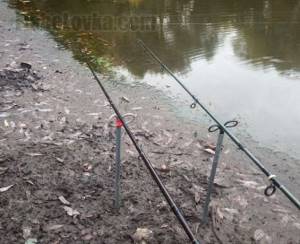
Photo 2. Fishing can be done on two feeders at once.

